The ubiquity of “kulturkampf”
I’ve already written a lot of essays about women’s maternal and other sex-specific traits, and how the mass entry of women into public life, in the last several decades, has brought those feminine traits to bear on culture and politics, driving extensive and ongoing changes in Western societies.
I am convinced more than ever that that “great feminization” argument is essentially correct. But there is another facet of male/female cultural competition that I have mostly overlooked until now. It’s really something that relates to groups in general, not just to women, but I think it’s especially relevant to the current female-driven social transformations of Western societies.
The idea here is that, when women a few decades ago began to achieve parity/dominance vis-à-vis men in professions and institutions across the West, they automatically set up a rivalry, a “battle of the sexes,” in each of these professions and institutions. Why? Not because of any particular “female” or “male” trait, but simply because the two sexes are different in general. They have different group identities, different ways of thinking, different group cultures. If only at an instinctive, nonconscious level—and if only to avoid the emotional pain of having to conform to the others’ ways—each has sought dominance over the other.
This certainly seems to be true from women’s perspective. You can hardly open a newspaper or browse news websites these days without encountering lamentations, by female writers, about male workplace behavior—from the mildly irritating to the supposedly traumatizing. These behaviors typically are blamed upon the male domination of the workplace in question, although from my (admittedly biased, male) perspective these complaints often look more like attempts to stamp out the last vestiges of male culture in workplaces that are already significantly feminized.
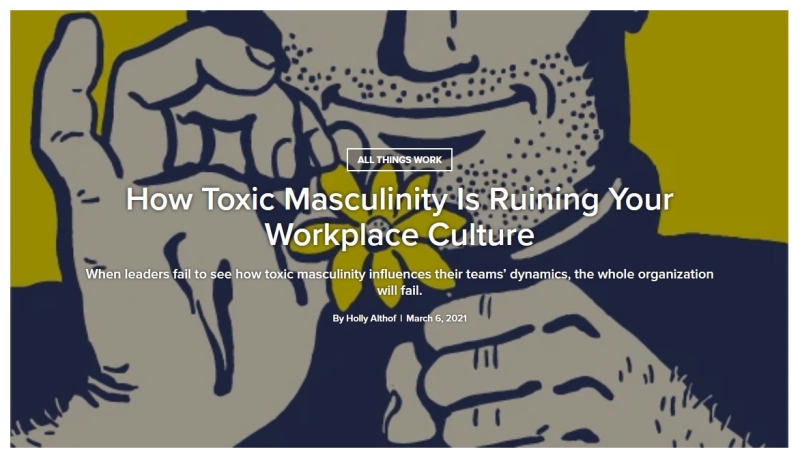
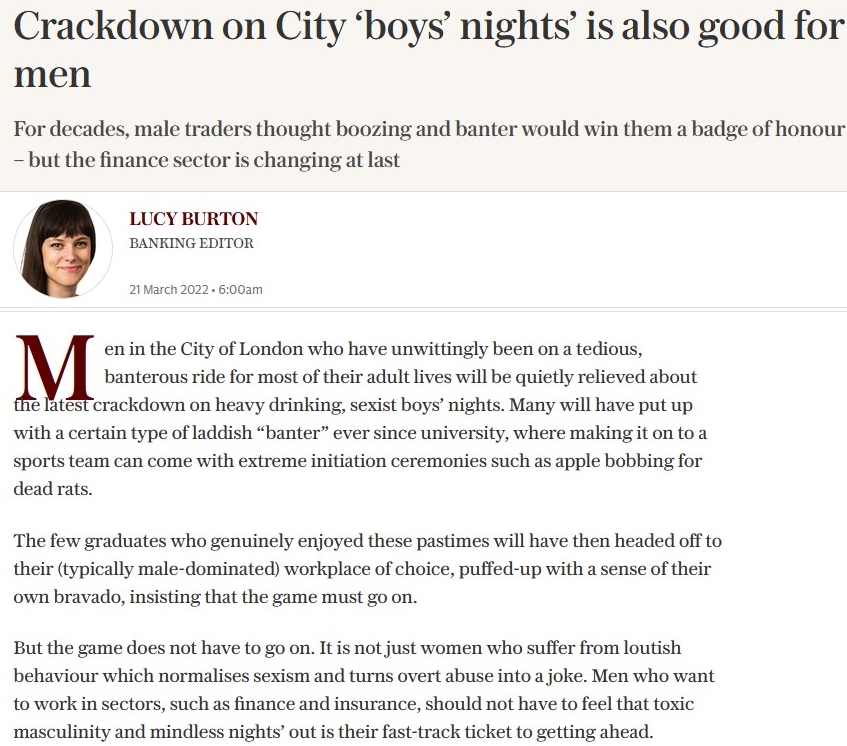
Women in their workplaces nowadays also—typically with the thinnest of formal rationales—are apt to organize emotional coalitions to oust their male CEOs or other leaders whose ways are insufficiently accommodating to the current female mindset.

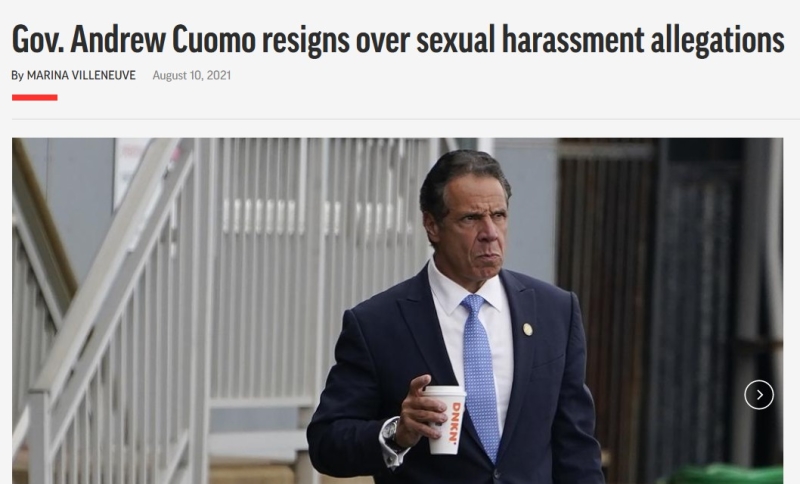

I suppose that if one ventures into the “manosphere” reaches of the Internet, one will find similar complaints from men trapped in female-dominated institutions. One will strain to find similar victories, though.
On the whole, the institutional battle of the sexes is something that seems to have really crept up on men, creating a challenge for them that they may be unable to surmount. Men, in particular the white, European-derived men who created the institutions of Western civilization, were trying to be progressive and even-handed when they welcomed women into the workplace (they were relatively welcoming, compared to Asians, Arabs, Africans, etc.). They were trying to be meritocratic. Arguably that relatively fair-minded meritocratic mindset was a psychological or cultural trait that helped Western men build their civilization into the powerhouse it was. (Most men also regarded the scaled-up presence of women in the workplace as a colossal and wondrous sexual opportunity.)
What men didn’t reckon with is that women eventually would reach a certain level of presence and power in the institutions and professions where they worked—a critical mass, as it were—and from that point onward would tend to seek not parity but dominance, and by just about any means.
I submit that we are already seeing this reach for (and, frequently, achievement of) female dominance across multiple institutions and professions. While the most visible manifestation is the one I just mentioned—the noisy cancellation coalition that dislodges a problematic male executive (who is often replaced with a woman)—women also have been feminizing their institutions, and crowding out men, in much less newsworthy ways, e.g., the practice of “preferred pronouns,” “inclusive,” i.e., non-meritocratic hiring including quotas for female execs and board members, mandatory pro-diversity statements, and feminist/ESG/green constraints on investment and general corporate policy.
The upshot of this organizational capture is, of course, women’s use of these entities to promote the wider feminization of culture and politics—often synonymous with “wokeification”—which, again, I have written about elsewhere.
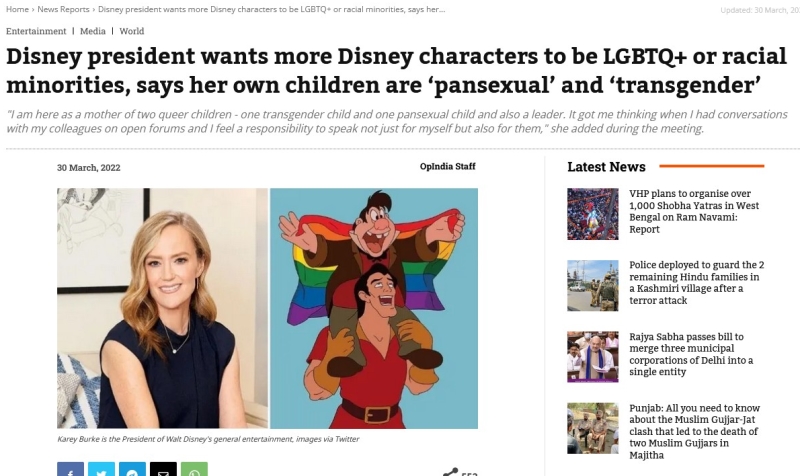
Their steamrolling victories suggest that women are much more powerful and effective than men in these institutional struggles, and, in a way, this should be unsurprising: Men presumably have not been under long-term evolutionary or cultural pressure to cope with competition of this kind from women. Women, on the other hand, as the weaker sex, have long had need of “force multiplier” tactics and instincts.
I strongly suspect that women’s greater power derives especially from a set of closely related female traits that include superior emotional sensitivity, superior sociality, superior ability to catch and transmit social contagions, and superior ability to form emotional coalitions—traits that, again, may have evolved not just in support of maternal functions, but also as special weapons in contests with otherwise dominant males. (I have touched on these points in previous essays, e.g., here and here.)
Of course, women also benefit tremendously from the civil rights dogma and legal regime that has gripped the US and some other Western societies for decades now, and often designates women as “traditionally disadvantaged” and thus worthy of favorable treatment, especially vis-à-vis white males.
Other groups
As I suggested at the top of this essay, women’s quest for supremacy within traditionally male institutions/professions is just one specific example of a much more general phenomenon of modernity. In other words, my hypothesis here is that any two (or more) groups that are sufficiently well defined and coherent, with sufficiently distinct group identities and cultures and so on, are bound to vie for control, to some extent, whenever they occupy the same social space.
Ethnic/racial groups are probably the most obvious examples of highly coherent but non-gender-defined groups that we would expect to see in these wars for institutional supremacy. As in the case of women vs. men, some of these ethnic/racial groups, due to their own particular traits, will be better than others in such contests. Immigrants to Western countries, especially those who have to travel from remote parts of the world, already tend to be the smartest, most ambitious, get-up-and-go members of their societies. Moreover, some of those societies are already highly stratified, with highly intelligent, highly entitled, highly ambitious (even ruthless) upper strata—so the immigrants from those upper strata are really going to pose a challenge to Westerners in the context of institutional struggles.
Thus, we are essentially looking at the flip side, the dark side one might say, of the fact that America and other Western countries attract the world’s best: Yes, many of these immigrants are the best, or are at least highly ambitious and sharp-elbowed, but that also means that they may soon have your job—and may even control your organizations.
Additionally, virtually any non-legacy-Western ethnic group is nonwhite, and ipso facto will be granted further strong advantages by contemporary civil rights culture. These advantages, over the past fifty-odd years, have included preferences/quotas in academic admissions, in public and private job hiring, and in government contracting—even when the group’s members have hailed mostly from elite, wealthy castes in the home country, and have not been “disadvantaged” in any sense.
Apart from the very tangible, often windfall-scale benefits of this civil rights regime, there has been, especially in recent decades, a civil rights mindset within organizations, a mindset that provides a further advantage to nonwhite ethnicities. Cloaking themselves in civil rights victimhood, preaching about the need for more diversity and equity, calling out alleged racists and racism, nonwhites can basically activate and direct that mindset as a further, quite powerful tool for displacing legacy Whites, for individual and group benefit.
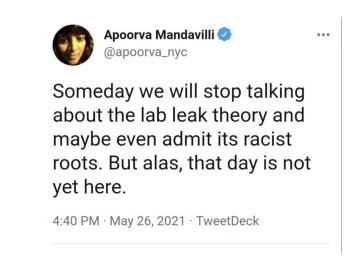
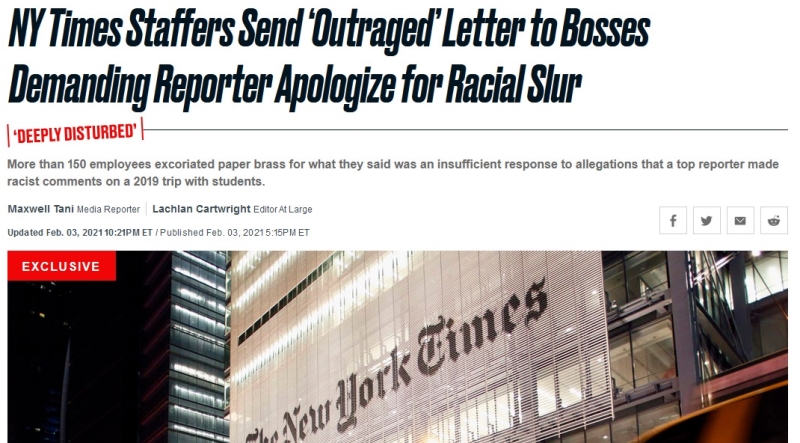
I can think of at least several ethnicities that are doing very well in Western societies for the reasons I’ve just described. Indians are probably the most obvious example. They make up only about 1.5 percent of the US population now, and were hardly visible at all in the country half a century ago, but already they are strikingly overrepresented in the ranks of big-company CEOs as well as in other influential professions such as law, medicine, and politics.
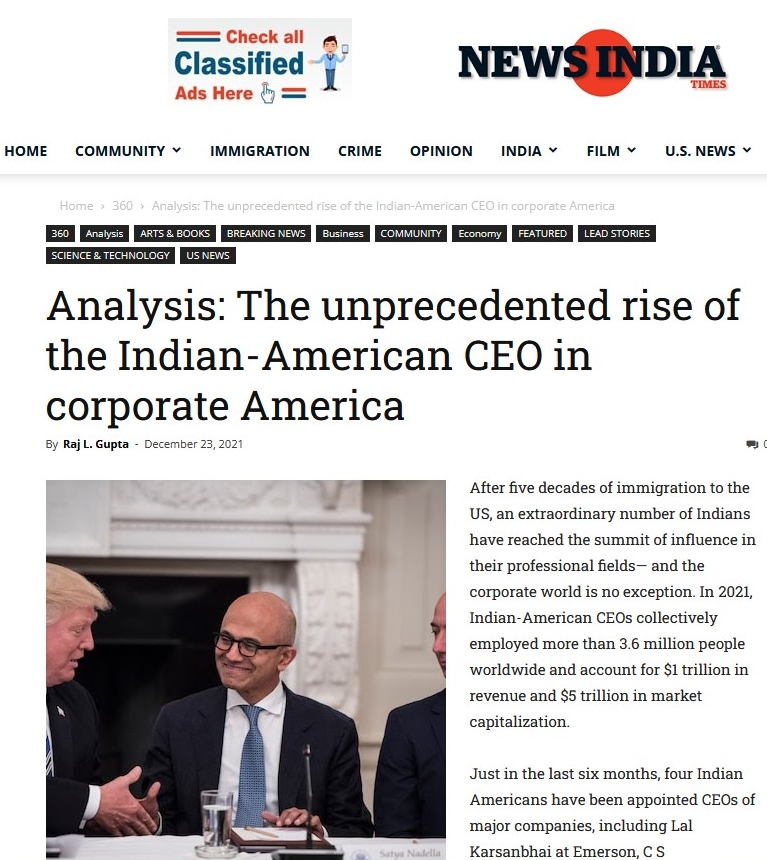
Again, according to this general hypothesis, the struggle for control of institutions and professions could involve any other type of group with a significant presence and a sufficiently distinct and coherent identity. I think there are not many good examples beyond gender- and ethnicity-based groupings, but surely the “LGBTQ community” is one that has had some success in influencing big organizations’ policies.

A General Hypothesis of Cultural Struggle
To sum up, then, my hypothesis is that a “collective instinct” to vie for supremacy over institutions/professions is something that occurs to some extent, and more or less automatically, even non-consciously, within all well-defined, cohering groups of significant size within those organizations. Different groups will have different traits that affect the intensity of their participation, their strategies, and their overall chances of success in these struggles. Some will also be advantaged or disadvantaged by the surrounding law and culture, e.g., civil rights law and culture.
I am not sure how original this idea is. Certainly, the idea of group culture is not new; nor is the idea of a struggle between cultures—what the Germans call a kulturkampf—novel. But the idea that such a struggle begins almost automatically when two or more rival cultures share a defined social space—a profession, an organization, a country—is one I don’t think I have encountered before.
I may not have emphasized enough that this “struggle” normally, for most of its participants, would be relatively subtle and even non-conscious. We all have our conscious explanations of, and justifications for, the things we do, but clearly there is a lot of other stuff going on under the hood—under the “limen,” the threshold of consciousness, as psychologists call it. Thus, Sanjay from the IT department may not be consciously plotting to dislodge the white CEO of his corporation; but, if asked to sign a petition decrying overheard off-color remarks by his company’s white CEO at a recent company retreat, he may be, ceteris paribus, much more likely to sign it if he knows the replacement CEO will be one of his countrymen—even if he isn’t consciously aware of that knowledge’s influence on him.
Another point to emphasize is that many, maybe most large organizations and institutions will have more than one group vying for control (e.g., women, assorted nonwhites, LGBTQs) against the legacy group (white males). These factions will coalesce and separate as needed, negotiating power-sharing strategies and arrangements, one faction slipstreaming behind another that has more power, and so on—similar to the workings of political parties in a multiparty system.
The uniqueness of whites
I have hesitated to include the legacy managerial class—white males—as combatants in these ubiquitous struggles, for the simple reason that they seldom seem to put up a fight. It’s downright eerie how some of these guys, no matter how innocent, will grovel, apologize, and plaintively attempt to appease when attacked, instead of showing any kind of defiance. It’s also odd that these men are so easily isolated; they are like those hobbled old wildebeests from the nature documentaries: left behind by the panicked herd for the pursuing, shrieking jackals to surround and kill at their leisure.
As for most of this social-psych territory, I can only speculate about the source of white males’ peculiar weakness and apathy. Maybe just having been on top for so long is enough to erode the mojo needed to stay there; maybe success has made us too soft, as the ascendant Greeks of antiquity said of the descendant Persians. Maybe we also developed psychological tools, such as hyper-individualism and relative cultural openness, that were once highly adaptive in enabling us to build our great civilization, but now leave us vulnerable as our environment becomes more post-patriarchal and multi-ethnic, and the protection and promotion of the “tribe” acquires a renewed importance.
Indeed, we aren’t merely passive in the face of challenges from women and nonwhites. We—a huge number of us anyway—are quick to respond with active self-loathing and self-abasement. Our women are even quicker in this regard, so I guess that this represents not a male trait but a white trait: a guilt/appeasement reflex that is related to emotional sensitivity and social (“virtue”) signaling.

Whatever the cause, it is or should be remarkable, not to mention alarming, that nonwhites don’t seem to have this self-abasing, guilt-signaling reflex. Nonwhites have at least many skeletons in their ancestral closets as whites do—everyone living now is the beneficiary of hundreds of invasions and genocides going back to ape-men times. Yet I’m sure I’ve never heard an Indian, a Nigerian, or a Filipino lament his own ongoing, deliberate colonization and exploitation of the countries of the West.
Implications
In principle, some struggles between group cultures will merely simmer, remaining unresolved indefinitely, because the factions that would challenge the incumbent white male faction cannot put together the numbers to prevail, or simply because a certain number of white males are needed to keep the organizational ship afloat. But now in the 2020s, after six decades in which Western women and nonwhites have been crowding into Western professions and institutions (lately empowered by blatantly anti-white-male ideology) they seem to be seriously reaching for supremacy, at least wherever white males and their mindset are less necessary.
In any case, one implication of this hypothesis is that adding “diversity” to an organization doesn’t necessarily bring it closer to some happy, stable equilibrium. It may, instead, disrupt what had been a relatively stable balance of forces, stimulating anew the struggle(s) for dominance in that organization—and leading to the further marginalization of white males.
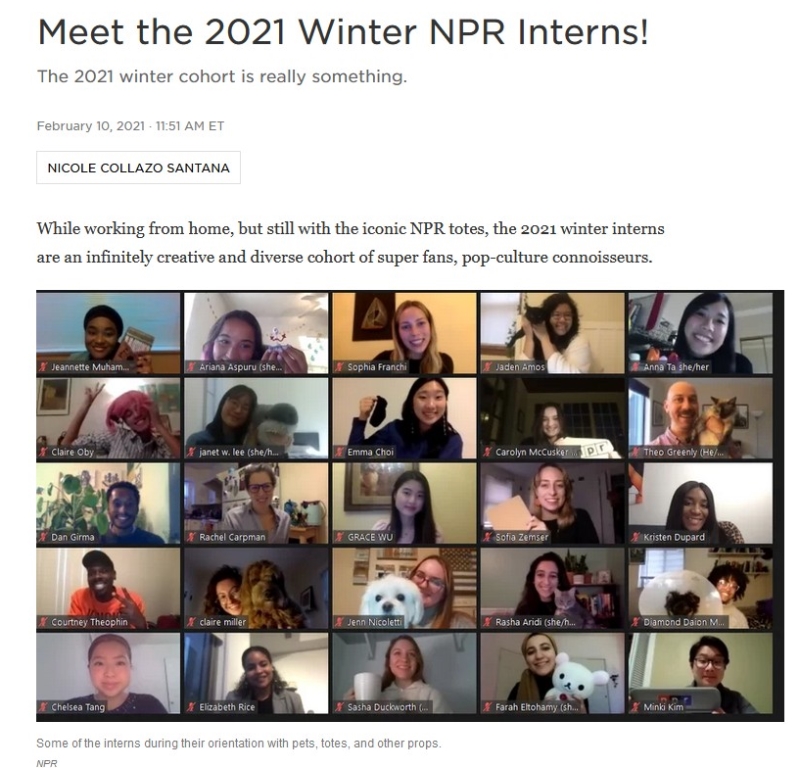
Moreover, struggles among factions within organizations reflect, and also to a great extent add up to, a struggle at the societal level. By this reasoning, increasing demographic diversity in Western societies via mass-nonwhite-immigration is simply adding fuel to the kulturkampf fire, making ethnic factionalism burn hotter to the detriment of most, and increasing the chances that at least in some countries, nonwhites will prevail—marginalizing whites in their own lands.
* * *
